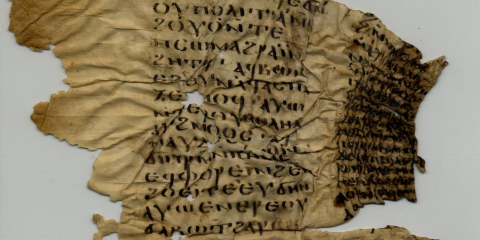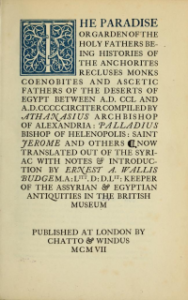The history of Martin Guerre would probably surprise the main protagonists of this tale. In 1548 Martin Guerre abandoned his family and disappeared from this home in Artigat, located in the Occitanie region of France1 .
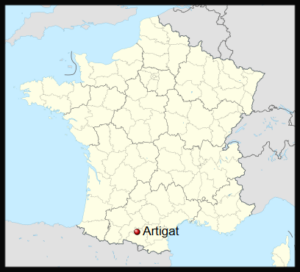
Artigat – The Stage
By all accounts the marriage was not particularly happy and there were no children for the first eight years, until a son was born. Then, due to a series of unfortunate events, it is clear that Martin was having a hard time. Thus the disappearance of Martin probably did not come as a surprise.
Nine years later, in 1557, a person appeared in Artigat claiming to be Martin. From his looks and his knowledge of village life he was quickly welcomed back. Even though there were suspicions about this person, he was accepted by Martin’s sisters and uncle, and more importantly by Bertrande de Rols, Martin’s wife.
Moving in, he lived in every respect as Martin Guerre, carrying on the business of the family, claiming an inheritance when the elder Guerre died. Bertrande and Martin had two further children. As often happens when there is money and family involved, rumors started to circulate. A passing soldier claimed that this Martin was a fraud for he knew the true Martin. Inflaming passions Martin was attacked but Bertrande protected him. Yet the die was set. In 1559 Martin was accused of impersonation and other petty crimes. He was acquitted in 1560 primarily due to the continued support of Bertrande. Many were not convinced and the court could not ignore the charges, Martin was retried in a new venue (Rieux). This time Bertrande, pressured by her mother and Martins brother, Pierre, agreed to bring a new complaint that this Martin was really Arnaud du Tilh, a ne’er-do-well from a nearby village. The trial included more than 150 witnesses and those who were willing to give an opinion were almost evenly split on the the facts of the case. This time, Martin, identified as Arnaud du Tilh, was convicted and sentenced to death.
As was his right, the convicted man appealed and the Parlement of Toulouse took up the case. Pierre and Bertrande were arrested. Martin (Arnaud du Tilh) presented a strong claim. He was able to relate the history of Martin, his marriage to Bertrande, in explicit detail, and had good evidence that Bertrande was being pressured by Pierre to deny his claim. So strong was the evidence that the judges were close to acquitting him.
Wait for it – with drama worthy of a movie, a man, with a wooden leg appeared claiming to be the real Martin Guerre. His story was fuzzy, he did not get all the facts straight. But Pierre, Bertrande, and Martin’s sisters were all convinced that the man with the wooden leg was the real Martin.
As with many tales like this, Arnaud du Tilh confessed that he was an imposter and was hanged at the front door of Martin Guerre’s house. Martin was not happy with Bertrande, and rejected her apology. But eventually they reunited and lived out their lives. In 1594, the sons of the late Martin Guerre divided his property.
This is only the beginning of the story of Martin Guerre.
Martin’s Reappearance
The Early Modern Period Interpretation – The trial of Arnaud du Tilh
The Judge
The tale of Martin Guerre and Arnauld du Tilh was first recounted by one of the Toulouse parlement judges, Jean de Coras, in his trial record Arrest Memorable du parlement de Tolose (1561)2 (See the English Translation of the de Coras account by Jeannette K. Ringold). By all accounts de Coras was conflicted in his ruling. He was able to see both sides of the case, Martin’s abandonment of Bertrande yet the lawful husband, versus Arnauld du Tilh, an interloping imposter but apparently the more credible husband and witness. In the end, de Coras submits to the “proof by witnesses”3 in his final judgement to convict Arnauld du Tilh and release Pierre and return Bertrande to Martin Guerre. A second edition of Arrest Memorable was published in 15654.
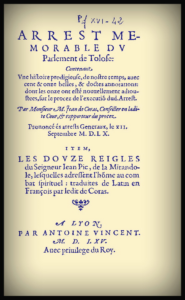
Title page of Jean de Coras’s 1565 edition of
Arrest Memorable
Recounting Martin Guerre’s story as a part of French history
Within the year the celebrity of the case spread throughout Europe and was reported by other French scholars. Étienne Pasquier begin compiling his History of France, Les Oeuvres d’Estienne Pasquier, contenant ses recherches de la France, in 15605 . The story of Martin Guerre is recounted in the first volume of this history.
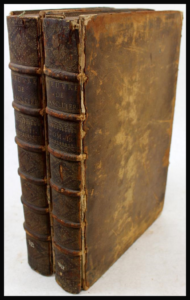
1723 Edition of Recherches de la France
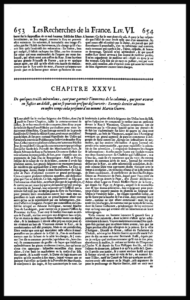
The chapter on Martin Guerre
recounted by Pasquier
Soon thereafter, Guillaume le Sueur published his Histoire admirable d’un faux et supposé mary, advenue en Languedoc, l’an mil cinq cens soixante in 15616 . As noted above, de Coras is a firsthand participant in the trial it is assumed that he is the source of the account of Martin’s story. Both Pasquier and le Sueur provide different details so it is difficult to determine their authority. These sources tend to revolve around the “problematic nature” 7 of the trial, the “perplexity” of the trial process when the judges clearly think that there is as much wrongdoing by Martin as there was by Arnauld. Analysis from writers of this period often takes into account the broader cultural world view of the time. Questions of Cannon Law and the rising conflict between Protestant thinking and the Catholic Church are important themes for the 16th and the 17th century writers. Indeed, Jean de Coras was a Protestant convert and was killed in October 1572 during turmoil that followed the Saint Bartholomew’s Day Massacre, along with other judges from the Toulouse parlement8 .
No doubt the personal story of de Coras should be considered as a backdrop to understanding the events of this tale. We need to consider the narrative of, and the perspectives on morality, faith, culture, and the voice of these authors when looking at the tale of Martin Guerre. As we will see below, modern authors appear to read their own time and place into their reinterpretation of the Martin, Arnaud, and Bertrande.
20th Century reinvention of the meaning of the tale of Martin Guerre
- This summary was derived from several the resources listed in our post.
- Coras, Jean de
1561 – Arrest Memorable, du Parlement de Tolose, Contenant une histoire prodigieuse, de nostre temps, avec cent belles, & doctes Annotations, de monsieur Maistre Jean de Coras, Conseiller en ladite Cour, & rapporteur du proces. Prononce es Arrestz Generaule le xii Septembre MDLX. Lyon: Antoine Vincent, 1561. Avec Privilege du Roy. (Quarto.)
- Translation of the main text of Coras, Arrest Memorable, by Jeannette K. Ringold, in Triquarterly 55 (Fall 1982): 86-103 – (p. 15 in http://people.wku.edu/nathan.love/Multi-handouts/coras_arrest_memorable.pdf)
- Coras, Jean de
1565 – Arrest memorable du parlement de Tolose : contenant, une histoire prodigieuse, de nostre temps, avec cent & onze belles, & doctes annotations : dont les onze ont este´ nouvellement adjoustees, sur le procez de l’execution dud. arrest. Par monsieur M. Jean de Coras, conseiller en ladite cour, & rapporteur du procez. Prononce´ e´s arrests generaux, le XII. septembre M.D.L X. Item, Les douze reigles du seigneur Jean Pic, de La Mirandole, lesquelles adressent l’homme au combat spirituel : traduites de latin en franc¸ois par ledit de Coras. Jean de Coras; Jean Pic de la Mirandole; Jean de Lasseran de Massencome Montluc, seigneur de); Antoine Vincent; France. Parlement de Toulouse, A Lyon. Par Antoine Vincent. M.D. LXV. Avec privilege du Roy.
- Pasquier, Etienne
1723 – Les oeuvres d’Estienne Pasquier, : contenant ses Recherches de la France; son Plaidoye´ pour M. le duc de Lorraine; celuy de Me Versoris, pour les Jesuites, contre l’Universite´ de Paris; Clarorum virorum ad Steph. Pasquierium carmina; Epigrammatum libri sex; epitaphiorum liber; Iconum liber, cum nonnullis Theod. Pasquierii in Francorum Regum icones notis. Ses lettres; ses oeuvres mesle´es; et les Lettres de Nicolas Pasquier, fils d’Estienne. Etienne Pasquier; Pierre Versoris; Nicolas Pasquier; Compagnie des libraires associe´s (Paris, France), A Amsterdam [i.e. Tre´voux] : Aux depens de la Compagnie des libraires associez. M. DCCXXIII. [1723]. Estienne Pasquier, started the compilation of the work in 1560 – we are using the 1723 edition.
- Sueur, Guillaume le
1561 – Histoire admirable d’un faux et supposé mary, advenue en Languedoc, l’an mil cinq cens soixante – In E´douard Fournier, – 1855 – Varie´te´s historiques et litte´raires : recueil de pie`ces volantes rares et curieuses en prose et en vers. Tome 8. Fournier, E´douard (1819-1880). E´diteur scientifique. P. Jannet (Paris) [puis] Pagnerre (Paris) 1855-1863
- Perez, J. Tronch
2011 – The Touch of Man on Woman: Dramatizing Identity in The Return of Martin Guerre IN Mark Thornton Burnett; Adrian Streete. Filming and performing renaissance history. Basingstoke : Palgrave Macmillan, 2011. p. 50
- Mentzer, Raymond A.
1994 – Blood and Belief: Family Survival and Confessional Identity Among the Provincial Huguenot Nobility. West Lafayette, Ind. : Purdue University Press, p. 36.


